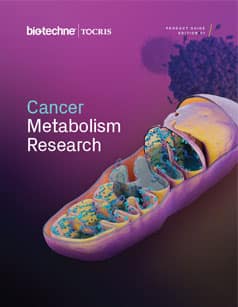Monoacylglycerol Lipase
Monoacylglycerol lipase (MAGL, MGL) is a hydrolase that is involved in endocannabinoid and triglyceride hydrolysis. It is the primary enzyme responsible for the metabolism of 2-arachidonylglycerol (2-AG) in the brain, and is also involved in lipid signaling.
Monoacylglycerol Lipase Inhibitors |
|
|---|---|
| Cat. No. | Product Name / Activity |
| 5206 | JJKK 048 |
| Potent and selective MAGL inhibitor | |
| 3836 | JZL 184 |
| Potent MAGL inhibitor | |
| 4715 | JZL 195 |
| Dual FAAH and MAGL inhibitor | |
| 5851 | JZP 361 |
| Potent and selective reversible MAGL inhibitor | |
| 5844 | JZP 430 |
| Potent and irreversible α/β-hydrolase domain 6 (ABHD6) inhibitor | |
| 4872 | KML 29 |
| Highly potent and selective MAGL inhibitor | |
| 6738 | KT 182 |
| Potent, selective and irreversible α/β-hydrolase domain 6 (ABHD6) inhibitor | |
| 5317 | WWL 123 |
| α/β-hydrolase domain 6 (ABHD6) inhibitor; antiepileptic | |
Monoacylglycerol lipase (MAGL, MGL, α/β-hydrolase domain-containing 6 acylglycerol lipase) is a serine hydrolase that breaks down monoacylglycerols to glycerol and fatty acid. It is the primary enzyme responsible for the metabolism of 2-arachidonylglycerol (2-AG) in the brain, and is also involved in lipid signaling.
2-AG acts as an endocannabinoid - an endogenous agonist of GPR55, CB1 and CB2 receptors. MAGL hydrolyzes 2-AG, attenuating endocannabinoid signaling and also generating arachidonic acid, which can be used in the synthesis of pro-inflammatory eicosanoids such as PGE2. MAGL inhibitors can therefore exhibit both antinociceptive and anti-inflammatory effects.
2-AG is structurally similar to anandamide (AEA), but the latter is hydrolyzed by fatty acid amide hydrolase (FAAH). FAAH and MAGL co-localize with CB1 receptors in the hippocampus, cerebellum and amygdala, but are distributed in different areas of the synapse - FAAH is expressed postsynaptically, whilst MAGL is expressed in the presynaptic terminal. Both enzymes play an important role in retrograde endocannabinoid signaling, as 2-AG and AEA activate CB1 receptors expressed in the presynaptic terminal to inhibit neurotransmitter release. Hydrolysis of these endocannabinoids by FAAH and MAGL prevents persistent CB1 receptor activation and desensitization.
MAGL was initially discovered in the context of lipid signaling in adipocytes. The enzyme hormone sensitive lipase (HSL) hydrolyzes triacylglycerols to monoacylglycerols, which are in turn hydrolyzed by MAGL to release free fatty acids. This is the last step of hydrolysis in adipocytes, and provides fuel during periods of glucose deprivation. The free fatty acids released from monoacylglycerol hydrolysis may be used in the synthesis of prostaglandin E2 (PGE2) and lysophosphatidic acid (LPA), dysregulation of which has been linked to cancer. Recent research has shown that MAGL may control the generation of free fatty acids in cancer cells, enabling them to fuel tumor growth.
External sources of pharmacological information for Monoacylglycerol Lipase :
Literature for Monoacylglycerol Lipase
Tocris offers the following scientific literature for Monoacylglycerol Lipase to showcase our products. We invite you to request* your copy today!
*Please note that Tocris will only send literature to established scientific business / institute addresses.
Cancer Metabolism Research Product Guide
This product guide reviews some of the main areas in cancer metabolism research and lists around 150 products that can be used to investigate metabolic pathways in cancer including:
- Glycolysis
- Tricarboxylic Acid Cycle
- Lipidogenesis
- 1C Metabolism and Nucleic Acid Synthesis
- Drivers of Metabolic Reprogramming
- pH and Redox Balance
Addiction Poster
The key feature of drug addiction is the inability to stop using a drug despite clear evidence of harm. This poster describes the brain circuits associated with addiction, and provides an overview of the main classes of addictive drugs and the neurotransmitter systems that they target.
Cancer Metabolism Poster
This poster summarizes the main metabolic pathways in cancer cells and highlights potential targets for cancer therapeutics. Genetic changes and epigenetic modifications in cancer cells alter the regulation of cellular metabolic pathways providing potential cancer therapeutic targets.



